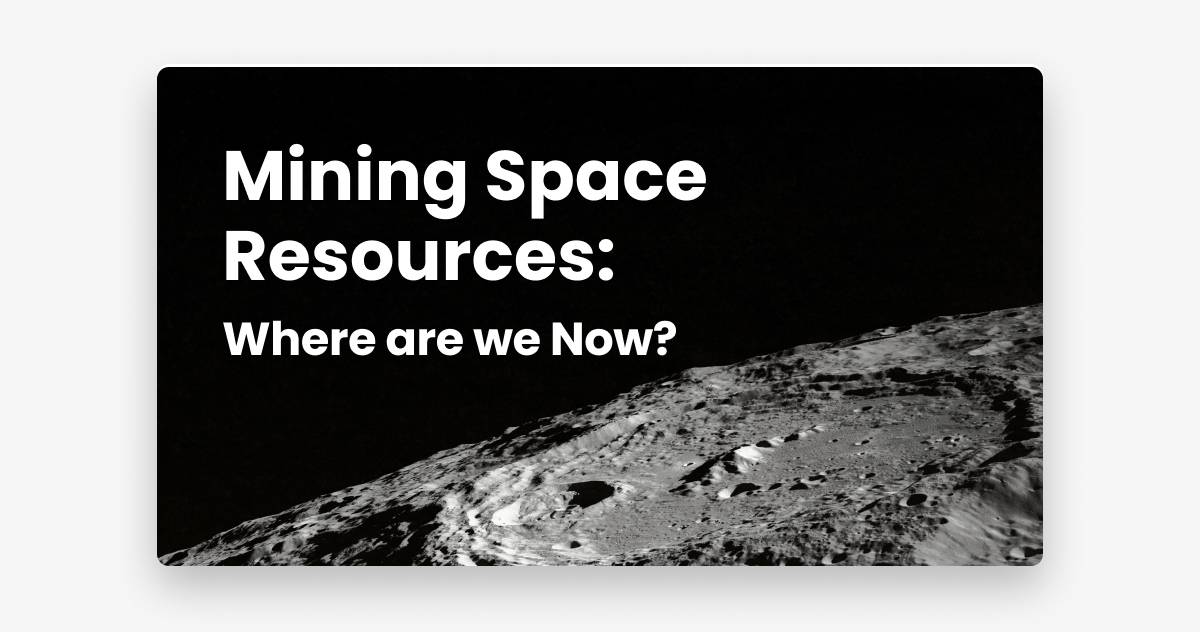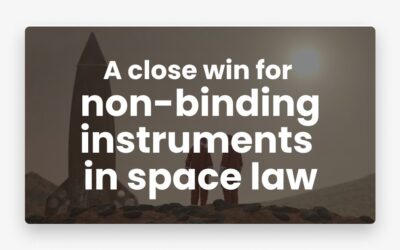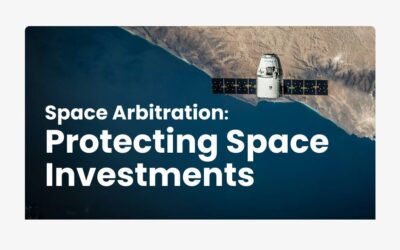Mining Space Resources: Where are we Now?
By Merryl Lawry-White
Mining space resources: where are we now? This post describes the space mining industry and the regulatory framework, and discusses arbitration of space mining disputes.
The Space Mining Industry
The development of the space resources industry is big—and increasingly bigger—business. Last year, Emergen Research predicted the space mining market will reach US$ 8.19 million by 2030 with a revenue CAGR of 23.5% between 2022 and 2030. According to renowned astrophysicist Neil deGrasse Tyson, “[t]he first trillionaire there’ll ever be is the person who mines asteroids for their natural resources”. The growth of the industry has garnered the attention of countries and companies. It is more prevalent in international discussions and national laws. There are hopes that the resources available in space will assist in addressing resource scarcity, one of the many ways that space may contribute to achieving the Sustainable Development Goals. According to the ESA’s Space Resources Strategy to 2030:
The challenges and environments of space drive optimised technologies and systems with implications for sustainability and the Sustainable Development Goals and addressing the increasing challenge of resource scarcity..
Space mining is essentially the process of excavating, extracting, and/or recovering resources from space. The Hague International Space Resources Governance Working Group—a multistakeholder Working Group established in 2016 with the purpose to assess the need for a governance framework on space resources and to lay the groundwork for such framework —defines a “space resource” as “an extractable abiotic resource in situ in outer space” and “utilization of space resources” as “the recovery of space resources and the extraction of raw mineral or volatile materials therefrom”.
The moon is the immediate focus of several mining efforts and “likely the first location for commercial mining”, where sought-after resources include regolith and Helium-3. Amongst other things, lunar resources may be used as fuel for deep space exploration and exploitation. The longer-term focus is on mining asteroids. In 2021, scientists discovered two metal-rich near-Earth asteroids whose reserves of iron, nickel and cobalt could exceed the global reserves of these metals. Major space agencies have engaged in exploration missions that will contribute to mining efforts. For example, JAXA’s Hayabusa missions returned samples of space rock. They have also engaged private companies to contribute to efforts. For example, in 2020, NASA awarded contracts to four companies to extract small amounts of lunar regolith by 2024 and transfer ownership to the agency.
Private efforts are also driving investment and innovation, although they face the challenge of the high costs associated with space mining and prospecting missions. Two United States (US) companies, Planetary Resources and Deep Space Industries, were established more than10 years ago with the aim of mining asteroids. They didn’t survive (in October 2018, Planetary Resources was acquired by ConsenSys, a blockchain technology company. Deep Space Industries was acquired in January 2019 by Bradford Space). The CEO and President of Planetary Resources noted in 2019 that: “[w]e haven’t figured out how to fund large-scale, long-duration, somewhat high-risk projects”. A new wave of companies that focus on elements of the mining journey are now the focus of significant investment. For example, in November 2021, the Los Angeles-based space company, Inversion, announced that it had obtained funding to develop an affordable means to return materials from space within the next three to five years. In May 2022, a new company, AstroForge, raised US$13 million in seed funding for its asteroid mining ambitions. Instead of bringing back the entire asteroid, AstroForge proposes breaking it up, refining, and returning to Earth only what’s valuable. While the first wave of companies has been termed “overambitious”, experts note that: “space mining has matured to the point where there are dozens of startup companies, even larger firms, addressing aspects of what’s called the space resources value chain”. At the same time, space mining is expensive, and thus entails risk for those investing in the sector.
The Regulatory Framework
These developments are testing and propelling the regulatory framework—at the international and national level. And with the investments sums and the magnitude of rewards and risks at stake, there is a drive for more consensus and certainty. Several States passed domestic legislation concerning the rights of private entities to explore, exploit and utilize space resources, and, in turn, allowing the States to regulate and licence the operators. These States include the US, Luxembourg, Japan and the United Arab Emirates (UAE). In addition, a 2020 US Executive Order encouraged the US to work towards building international support for the public and private recovery and use of space resources. It directed the US State Department to pursue a strategy of bilateral and multilateral agreements. In October 2020 NASA launched the Artemis Accords along with Australia, Canada, Italy, Japan, Luxembourg, the UAE, the United Kingdom and the US. The Artemis Accords are a set of principles for peaceful international cooperation in the exploration of space, including extracting space resources. At the time of writing (June 2023), there are 28 signatories to the Artemis Accords. These developments have raised questions around what international space law envisages, who “owns” the property rights in space and how benefits will be enjoyed. As the Luxembourg Space Agency explains regarding its 2017 Law on Space Resources:
International space treaties remain untested regarding who would own the rights to minerals, gases and water found in outer space. Until now, this has not been an issue since most missions have been for scientific purposes. But for commercial space projects and space mining to be viable, future explorers and investors will need to be certain of their rights to extract, consume and commercialise the materials they discover.
The relevant international regulatory framework is based on the five outer space treaties, and, regarding the right to explore and exploit space resources, particularly the Outer Space Treaty and the Moon Treaty. The Outer Space Treaty, which has been ratified by over 100 countries, codifies a principle of non-appropriation. Article 2 states: “Outer space, including the moon and other celestial bodies, is not subject to national appropriation by claim of sovereignty, by means of use or occupation, or by any other means”. The domestic laws passed in this arena state that they are in accordance with the Outer Space Agreement. Luxembourg, for example, clarifies that its Law on Space Resources “does not have an objective, purpose or effect of paving the way for any national appropriation of outer space, including the Moon and other celestial bodies themselves. The law clarifies Luxembourg’s national position on the status of the resources that can be extracted from those celestial bodies and in space in general”. The Moon Agreement has only been ratified by 18 countries and signed by four. The Moon Agreement classifies the moon and its natural resources as the common heritage of mankind. It also states that neither the moon, its subsurface nor any natural resources that form part, shall become the property of a State, international organization or a person. The US, for example, has been explicit in its view that the Moon Agreement does not represent customary international law and so is of limited relevance to non-States Parties. Some parties to the Moon Agreement—for example, Australia and Mexico—are also parties to the Artemis Accords, suggesting that they do not see the cooperation envisaged under the Artemis Accords as straying from the principles codified in the Moon Agreement, including that moon resources are the common heritage of mankind. France and India, also signatories to the Artemis Accords, have signed, but not ratified, the Moon Agreement. Pursuant to the law of treaties, they are obliged to refrain from acts which would defeat the object and purpose of the Moon Agreement, until they have made clear their intention not to become a State Party to the treaty. In January 2023, Saudi Arabia—one of the 18 States parties to the Moon Agreement—announced its withdrawal from the treaty. The withdrawal will take effect in January 2024. It did not give reasons, but there is speculation that it could be linked to avoiding any potential conflict between the principles set out in the Moon Agreement and its adherence to the Artemis Accords and its future plans for space activities. These developments demonstrate the continuing discussions around the exact parameters of the international norms in space.
During its 2022 session, the Legal Subcommittee of the United Nations Committee on the Peaceful Uses of Outer Space (COPUOS) created a Working Group on the Legal Aspects of Space Resource Activity and gave it a five-year mandate to gather information, study the current legal framework, and “assess the benefits of further development of a framework for such activities, including by way of additional international governance instruments”. There are multiple international legal questions implicated in space resource activity, including sustainability, information sharing and cooperation in scientific research and technological development, but any consensus framework will also cover who will benefit from the exploitation of space resources.
Arbitration
Where does arbitration fit into this picture? There are few public arbitrations concerning the space industry and the topic has been well covered elsewhere including on this blog. But, in brief:
Inter-State Arbitration: The dispute resolution provisions under the international space treaties are largely untested. So far, the only publicly known dispute raised under one of the space treaties occurred around 40 years ago between the USSR and Canada. The dispute was raised under the 1972 Liability Convention and concerned the disintegration of a Soviet space object, the Cosmos 954 satellite, in Canadian air space depositing hazardous radioactive debris on Canadian territory. The dispute was settled in 1981 pursuant to the USSR’s agreement to pay Canada 3 million Canadian dollars. The outer space treaties do not envisage binding inter-State arbitration, although States are, of course, free to agree to arbitrate their disputes if they wish.
Investor-State Arbitration: A handful of investor-State disputes have been brought under investment treaties, concerning satellite lease contracts, the allocation and use of spectrum and satellite interference. We may well see the greater use of investment treaties in relation to the space resources value chain, including because space mining, of course, implicates many questions frequently seen in investment-treaty arbitration, including the award and maintenance of concessions/licences and the supervisory role of States.
Commercial Arbitration: In the constellation of developing technologies, materials, equipment, investment and regulation, there are a multiplicity of contracts. The space resources value chain will give rise to specialist disputes, as well as disputes about general commercial questions that we see in other industries based on contractual interpretation—supply, manufacturing, distribution, procurement, protection of IP, data and information sharing, insurance, etc. or a combination of the two. As an industry, the general trend has been to negotiate and find a solution to disputes. This is understandable in a growing industry that requires specific expertise, with huge investment at stake, but with a limited number of players with the relevant expertise and products. One mechanism that has been used to limit disputes in commercial contract is the cross-waiver of liability by which parties waive their rights to sue each other under a contract. But we already see signs that, as the industry grows, there will be more disputes submitted to independent dispute resolution. The potential benefits of arbitration for space disputes, including concerning space resources, have been set out in detail elsewhere, but they include confidentiality, the ability of parties to choose arbitrators with a specific expertise or approach, emergency arbitration provisions, the integration of a procedure to gather expert evidence and relying on either party appointed or tribunal appointed experts, or both.
Specific initiatives tailored to cater to the characteristics of space disputes emphazise some of these features. These include the DIFC’s Space Courts, established in 2021, as part of the DIFC’s Courts of the Future. They also include the Permanent Court of Arbitration’s 2011 Optional Rules for Arbitration of Disputes Relating to Outer Space Activities, which have already been covered in detail on this blog. Two examples of key innovations in these rules include: a panel of scientific and technical experts, as well as arbitrators with specific expertise, in case the parties need assistance to benefit from these features of arbitration. The rules also empower the tribunal to request the parties to “submit a non-technical document summarizing and explaining the background to any scientific, technical or other specialized information which the arbitral tribunal considers to be necessary to understand fully the matters in dispute” (Article 27(4)). This assists the tribunal in deciding whether they need expert assistance and of what type. These initiatives have not yet (as far as is publicly known) been employed by players in the space industry. This may reflect that many of these disputes will also concern general commercial questions, although other reasons have been floated for the failure to employ the PCA Rules, in particular.
While space-specific arbitration rules may not have been employed, the disputes submitted to arbitration under generic arbitration rules, for example, the ICC Rules, demonstrate the potential utility of arbitration as a dispute settlement tool. Already in 2004, commentators were reporting that the ICC was a popular destination for disputes related to space activities (Ravillon, Laurence (2004) Space Law and Mechanisms for Dispute Settlement. ECSL News, No. 28 (December 2004), 2-3 (p. 2)). The ESA Convention, Annex 1, provides that “[w]hen concluding written contracts, other than those concluded in accordance with the Staff Regulations, the Agency shall provide for arbitration”.
It is certainly an industry and value chain to watch—at the international, transnational and domestic level—and, especially given the potential rewards and sensitivities involved, we are likely to see a growing appetite for the use of arbitration.
For further information on space mining disputes and space mining arbitration, please see this post by Laura Yvonne Zielinski.
You might also like
Investment Protection and Space Investors
Investment Protection and Space Investors By Luca Erhart and Riccardo LoschiInvestment Protection...
A close win for non-binding instruments in space law
A close win for non-binding instruments in space law By Ruvimbo Samanga"A close win for...
Space Arbitration: Protecting Space Investments
Space Arbitration: Protecting Space Investments By Katie MakSpace Arbitration: Protecting Space...


